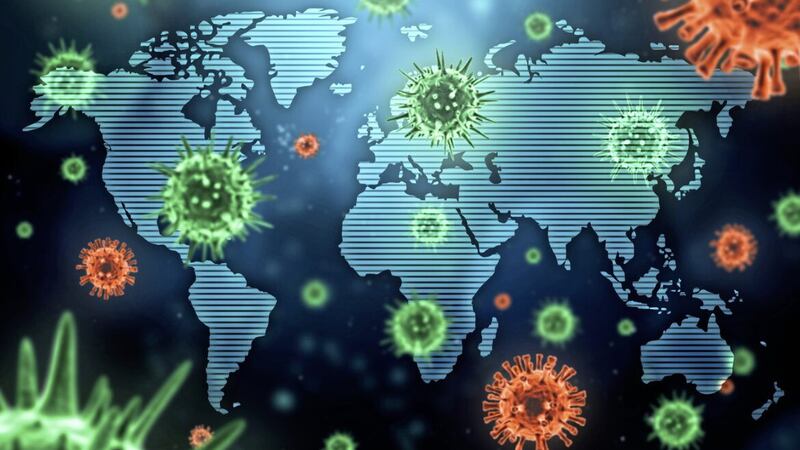SOMEWHERE in the world the next pandemic bug is silently evolving, getting set to burst upon us unawares - spreading faster and more lethally, perhaps, than even Covid-19.
But where, when and how will this deadly pathogen emerge? And what will it be? These are questions that confront infectious disease scientists who are already certain of one thing: Covid is but a harbinger of further global contagions.
So the race is on to develop new early warning systems that involve looking for danger signs in everything from traffic jams and sewage to old museum exhibits and even sales of garlic.
In July, Oxford University launched its new Pandemic Sciences Institute, a £100 million initiative dedicated to building global readiness to thwart new infectious threats.
It pools the university's rich expertise that enabled Oxford scientists to start the first human trials of its game-changing Covid-19 vaccine four months after the pandemic virus's genome was first decoded in 2020. Best known as the AstraZeneca vaccine, more than two billion doses have been given worldwide.
The onus will be on tracking viral threats in order to develop new drugs and vaccines at maximum speed. But that means identifying new pandemic bugs before they get the chance to run wild, says Christophe Fraser, a professor of infectious disease epidemiology and a key figure in the new institute.
"If Covid could have been contained at the start [when the first cases emerged in China], I think we would have avoided it," he said.
This could have been achieved, for example, by rapidly applying local lockdowns and bans on international travel, while scientists worked on developing new vaccines and drugs.
The 2003 Sars outbreak, which began in China and resulted in around 8,000 cases in 26 countries, was contained by lockdowns and travel bans that were instituted more rapidly than with Covid.
"We know from tests that if the Sars virus had been allowed to run uncontrolled, it would have evolved to become more infectious," says Professor Fraser.
"Ebola was also a close call in 2014. But Nigeria successfully contained the virus, which causes lethal haemorrhaging, within two months.
"Middle East Respiratory Syndrome (or Mers) in 2012 was a bit easier to contain [not least because it did not transmit easily from person to person], but that containment was not inevitable," he adds.
"We will have more pandemics," he warns, "but we can reduce how many we have in future by getting early data of newly emerging pathogens so that people can act on it in the right way."
Professor Fraser's fears are amply supported, with the UK government saying there's a 50 per cent chance of another pandemic on the scale of Covid-19 in the next 25 years.
The threat is rising, experts say, because large-scale human expansion into previously virgin habitats - such as forests - puts us into ever-closer contact with wild animals that harbour previously unknown pathogens.
But what are the vital early clues to an emerging pandemic?
"Often, we see the signs of a new outbreak before we see people getting sick," says David Bray, director of GeoTech Centre, a US body that champions the use of technology to improve our lives.
As an example, he explains how, 20 years ago, while working in global monitoring for United States health authorities, they noticed that in China the price of garlic - which is viewed as a cure-all for illness by a number of Asian cultures - had risen tenfold.
This spiralling demand suggested a sudden rush to buy the herbal folk remedy to salve fast-emerging respiratory problems. "This was the first sign of Sars, the predecessor to Covid," says Bray. "We spotted it five months before China revealed that it was experiencing an outbreak of a new respiratory coronavirus."
The same thing happened in early 2020, when the price of garlic again surged in China - an early sign of Covid-19 emerging.
And there were other early warning signs that were largely ignored at the time. Between August and December 2019, several months before most of us had heard of the virus, satellite images picked up a surge in road traffic outside hospitals in Wuhan, China, where the virus originated.
The 67 per cent increase in traffic was reported in a 2020 study by scientists at Harvard University, who found roads near five hospitals in the city had been much busier than usual - a pattern researchers attributed to patients sick with Covid-19 being rushed to emergency care.
With hindsight, the traffic images were crucial because they suggest the virus was spreading in the community three months before the first cases were confirmed by the Chinese authorities in November 2019.
The same study also picked up a steep rise, around the same time, in online searches in China for information on symptoms such as 'cough' and 'diarrhoea', both of which are common Covid symptoms.
Meanwhile, scientists are panning for epidemiological gold in cities' sewage systems. For if we become infected with pathogens, we excrete them in the loo. In 2020, a national wastewater monitoring programme was set up in England to monitor Covid traces in untreated sewage from around 40 million people.
It came after a pilot scheme in Cardiff, Manchester and Liverpool found local levels of viral DNA in sewage from Covid-19 matched infection rates - which meant sewage testing could be a valuable flag for local outbreaks.
Now investigators want to use this approach as an alarm system for emerging new pandemics.
An associate professor of civil and environmental engineering at Colorado State University, Susan De Long, reported in the journal Modern Sciences in May that wastewater entering treatment plants can be sampled for levels of viral DNA that will show if a new threatening infection is emerging.
"It can provide an early warning that public health measures [such as mask wearing, vaccination and working from home] may be warranted," De Long says.
"If wastewater monitoring had been part of the established public health infrastructure in late 2019, it could have provided an earlier warning that Covid-19 was becoming a global threat."
Social media trends may also help us spot pandemics early. When researchers at the University of Calabria in Italy analysed social media from late 2019, they detected rising concern about cases of pneumonia across Europe, before Covid-19 was widely identified.
Their study, in the journal Scientific Reports last year, focused on tweets related to pneumonia because it is the most severe Covid-induced condition, and also because the flu season in 2020 was milder than normal, which should have meant pneumonia cases were falling.
The scientists said monitoring social media may be a way to track signs of emerging pandemics.
Far away from social media, another way to predict pandemics is being pioneered. Curators at the National History Museum in London are uploading all their records of samples of bats and other potential animal sources of pandemic viruses to a worldwide database for scientists.
Three-quarters of all emerging infectious diseases are zoonotic - transmitted from animals to humans. Examples include rabies caught from dogs; HIV from apes; and Covid-19, thought to have originated in bats.
The museum has already digitised more than 30,000 records for bat specimens and another 6,000 are being processed. Samples are made up of skins, skeletons and preserved bodies.
Last year, similar work at the National Museum of Natural History in Paris revealed previously unidentified coronaviruses closely related to the Covid-19 virus lurking in the samples of two Rhinolophus shameli bats that had been taken in Cambodia in 2010.
Museum specimens such as these have already helped to identify a mysterious infectious disease outbreak that claimed 13 lives in the US in 1993.
Hantavirus pulmonary syndrome kills nearly 40 per cent of infected people by filling their lungs with fluid. Researchers at the Museum of Southwestern Biology at the University of New Mexico analysed hantavirus-infected deer-mice exhibits and identified the rodents as the species from which the lethal strain emerged.
Crucially, the researchers were also able to show that the virus had been circulating in local rodent populations for years and that its emergence in humans was linked to El Niño climate cycles.
These occur when the ocean currents warm in the Pacific, causing a heavy increase in rainfall in the southwestern parts of the US - thought to have driven virus-carrying creatures into closer contact with humans.
But Sir Peter Horby, director of the Pandemic Sciences Institute at Oxford University, is convinced doctors on the frontline will still have a vital role in highlighting emerging viral threats.
Pandemic alerts usually happen, Sir Peter says, "when a clinician sees a cluster of cases and sees this is odd. If they push the 'red button' and alert colleagues worldwide then the new pathogen can be detected further".
The chances of this happening may now be improved by using cheap technology, such as giving doctors in poorer countries free apps for recording data on novel illness symptoms. "The technology is out there to do all this," he says.
© Daily Mail








